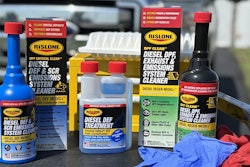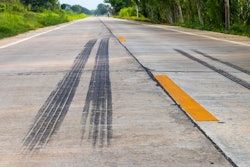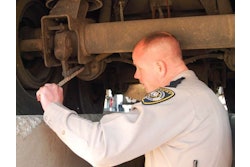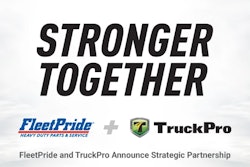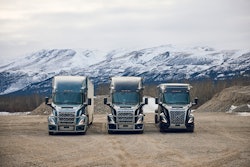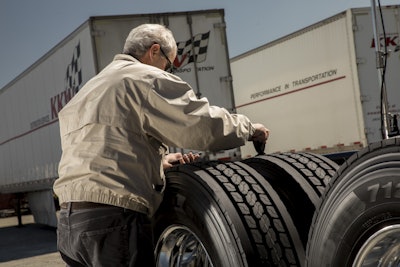
As the one of the largest operational costs for truckers, tires have a significant impact on a carrier’s bottom line.
Additionally, as the only components in contact with a roadway, tires are a truck’s first line of defense against potholes, speed bumps, curbs and other road hazards. They’re also influential to maximizing fuel economy, reducing stopping distances, and, thanks to treads, avoiding weather-related accidents.
Slick, tread-free tires might be the best option for race cars zipping around a track a few hours on Sunday, but for Class 8 tractors covering thousands of miles a week, treads are vital to ensuring drivers can maintain excellent traction in any driving conditions.
As Michelin’s Jim Garrett puts it, “Slick tires offer the best performance in terms of dry traction, but when you have any type of weather condition it makes them unmanageable. [Drivers] need to be able to maintain traction when the road is not completely dry, and that’s where treads come in.”
Treads come in handy for carriers and service technicians in other ways too.
[RELATED: Are you maximizing the sales potential of tire maintenance technologies?]
Developed for performance and designed to wear, treads provide a real-time status report of a truck’s driving performance. A tire that wears evenly across its useful life is verification of a driver and fleet manager’s job well done. But a tire that wears irregularly? That’s a warning sign of a bigger problem, and something a truck owner and service provider should immediately seek to address.
Improper inflation
Improper inflation is arguably the most common reason for irregular tread wear because over- and underinflated tires can lead to premature tread erosion. Underinflation is generally viewed as the more dangerous of the pair, says Garrett, Michelin’s product category manager, marketing for heavy truck tires.
Garrett says truck and trailer tires are designed to operate at a specific PSI with an optimal amount of deflection between a tire and the road. The deflection area, or “contact patch,” is where tread patterns are found, he says. An underinflated tire wrecks that formula by reducing the contact patch with the road surface, increasing heat at the ground level and wearing the tire incorrectly.
“Excessive deflection equals more heat and will bend a tire,” he says.
Bridgestone’s Robert Hamby, director of commercial product strategy, agrees. Hamby says, “You want to maintain that proper footprint on the road to provide maximum wear.”
[RELATED: DEF a simple solution for emissions; more complicated when it comes to maintenance]
Unchecked underinflation can lead to larger issues too.
“The heat generated from underinflation can actually cause the compound molecules of the tire to break down,” says Tim Abel, truckstop sales manager at CMA International/Double Coin Tires.
 Improperly inflated tires are unable to achieve proper deflection with the road surface and will wear unevenly on the inside or outside of the tire depending on the inflation issue. (Right click to enlarge)Michelin
Improperly inflated tires are unable to achieve proper deflection with the road surface and will wear unevenly on the inside or outside of the tire depending on the inflation issue. (Right click to enlarge)Michelin
“Casings are critical” to modern fleet tire maintenance programs, Hamby adds.
Experts say underinflation is identifiable not just in treads, which will have inconsistent patterns depending on heat levels and structural breakdown, but also in the side walls can will be stretched and stressed due to the improper pressure level.
Overinflation also reduces a tire’s deflection area, and causes exterior treads to wear faster than their interior brethren. Abel also notes an overinflated tire has a slightly higher risk of a shock failure due to a pothole or nail, for instance.
And improper inflation can be doubly challenging to a drive or trailer axle, where two tires on the same wheel end with competing PSI can wear differently and create drivability challenges.
“If you have two tires on a drive axle and that have a different PSI, they are basically fighting each other,” Garrett says. “One is slowing down and the other is driving to ‘catch up,’ essentially.”
In any case, experts say bringing tires back to their proper inflation level is the best way to halt negative inflation-generated tread trends.
“Once [irregular wear] it sets in you can’t reverse it, but rotating the tires slows it down,” Hamby says.
Mechanical or structural issues
Tire treads also can wear unusually due to upstream propulsion issues. Common issues here include a vehicle being out of alignment, a wheel end failure, a tire being improperly installed or even faulty, and more.
Tom Clauer, senior manager of commercial product planning at Yokohama Tire, says alignment can have a “huge impact on wear and drivability” for truck and trailer tires alike.
When a vehicle is out of alignment, it means its wheel ends (and tires) are not aligned correctly to each other and the unit’s suspension. Over time, this will show itself in a tire’s tread with uneven wear patterns, often showing excessive wear on the side of the tire in which the vehicle is pulling.
Less common but equally damaging to treads are tires that are incorrectly installed or feature a structural defect that inhibits free rolling. While the latter is extremely rare, it does require a replacement, whereas a faulty install can be corrected. Experts also note when a tire’s not running properly due to a mechanical issue, it’s often identifiable long before a tire’s treads are irrevocably destroyed.
“If the truck develops a pull, vibration or becomes noisy, these are good indicators that something is amiss,” says Clauer.
Adds Abel, “Usually there are indicators even before it shows up on the tires.”
Hamby agrees, adding a visual inspection will usually confirm what an issue a driver has flagged from the cab. “You can feel if a tire has smooth wear or doesn’t.”
In cases where a tire has worn unevenly but still has ample tread, rotating is often a carrier’s best bet to maximize the unit’s life cycle. “You’ll never get the full life, but you’ll get as much as you can,” says Garrett.
 Initial tire tread depth can vary based on position and application, but tire companies advise most customers to replace tires when treads reach 6/32" or less to ensure maximum tire performance and ensure retreadability.Yokohama Tire
Initial tire tread depth can vary based on position and application, but tire companies advise most customers to replace tires when treads reach 6/32" or less to ensure maximum tire performance and ensure retreadability.Yokohama Tire
Clauer agrees — “Once the rubber material is gone, it’s gone” — but also says federal minimum tread depths are 4/32 of an inch on steer axles and 2/32” on drive and trailer axles. With many new commercial truck and trailer tires entering the market with up to 32/32” tread depth, it’s unreasonable to expect fleets to discard a tire with substantial (albeit uneven) tread remaining.
Driver influence
Finally, it can’t be overlooked the impact drivers have on tires and their treads. Harsh braking, aggressive accelerating and exposure to road hazards are all ways drivers can reduce the tread and life of their tires.
Educating drivers of their influence on tire performance and life cycle can reduce but not completely eliminate driver-related wear incidents.
“Sometimes a driver is going to need to stop suddenly,” Garrett says.
But while hammering the brake pedal might seem like a tread killer (it definitely doesn’t help), Clauer says excessive torque created during rapid acceleration is far more damaging to treads.
“High driveline torque has a tendency to initiate heel-and-toe wear [on drive tires]”, he says. “This is basically the projecting of power of the drivetrain to the surface in order to move the equipment. In this case, the power transfer moves through the casing to the tread. The tread gets bent during this process and some scrubbing is done and a wear pattern can develop.”
 An example of heel-to-toe tire wearMichelin
An example of heel-to-toe tire wearMichelin
Steer and trailer tires avoid this fate but can wear in other ways.
Up front, Abel notes steer tires often take the brunt of alignment or inflation issues behind them because drivers will steer to one side to combat a vehicle pulling the other direction. They also wear more on their edges due to their responsibility for turning the vehicle, Garrett adds, which is why Michelin puts a “sacrificial rib” on the outside of steer tires to support turning and increase the longevity of interior tread.
Under the trailer, “side skidding” is a common problem, which occurs over time due to constant turning and wearing on treads while in use.
As for braking, slam-on-the-pedal stops can lead to flat patches where a tire will skid and burn off tread, Abel says.
He also notes even regular highway driving can impact tread wear. “Most truck tires are rated to about 75 mph,” Abel says. “But if you’re going 80, or 65, that will impact the life of the tire.”


